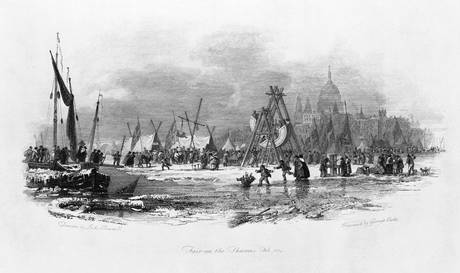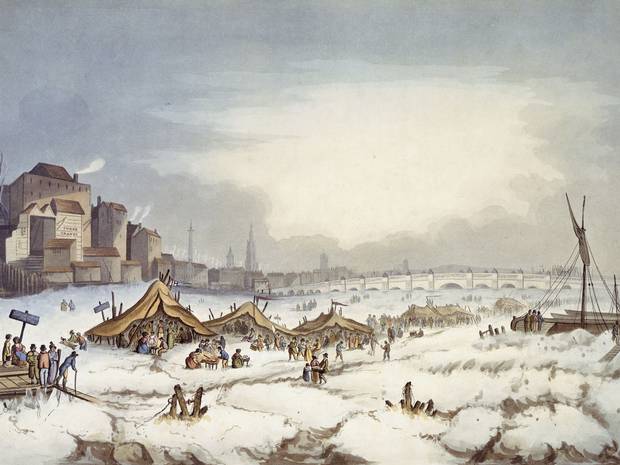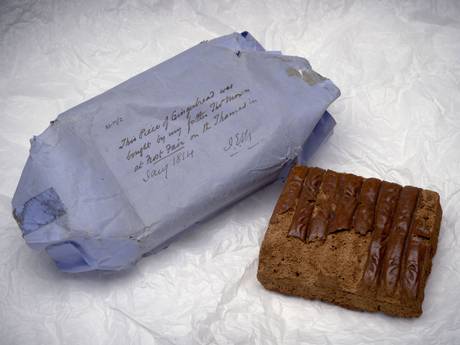"Father Frost and Sister Snow have boneyed my borders, formed an idol of ice upon my bosom, and all the lads of London come to make merry."
"Father Frost and Sister Snow have boneyed my borders, formed an idol of ice upon my bosom, and all the lads of London come to make merry."
Two centuries ago today, this was how one poetic soul announced for the last time an event unlikely to be seen again - the freezing of the Thames.
On 1 February 1814, Londoners awoke to find that after weeks of bitter chill, drifting snow and a fog which resembled "darkness that might be felt", the Thames had ground to an icy halt over a 1,000m stretch between Blackfriars and London Bridge.
The capital's inhabitants responded by settling down to a raucous and bibulous mid-winter party in the shape of a five-day Frost Fair.
In a meteorological event which seems unthinkable from the vantage point of the relentlessly soggy winter of 2014, London and much of England was gripped by temperatures which fell to -13C, bringing chaos as roads became blocked with snow to depths of 6ft. Tales were legion of mail coaches becoming trapped in drifts and the poor, unable to afford coal, freezing in their homes.
But in the midst of wintry misery, a brief respite was afforded as the flow of the Thames in central London slowed, ice floes formed and finally on the morning of 1 February the principal means of transportation for the wealth of the emerging British Empire became a frozen pleasure gardens. Within hours, boatmen deprived of their normal living derived from ferrying passengers across the river had set up signs declaring it was safe to walk across the ice.

Indeed, from temporary bars or "fuddling tents" fashioned from sail cloth and oars to sell strong concoctions of beer, gin and absinthe-like spirit to unconfirmed sightings of an ice-borne elephant, the sights and sounds of the Frost Fair were diverse.
Mr Davis, who set up a printing press on the ice to sell his book, wrote: "Among the more curious of these was the ceremony of roasting a small sheep, which was toasted or rather burnt, over a coal fire, placed in a large iron pan... The delicate meat when done, was a shilling a slice and termed Lapland mutton."
Along with other diversions hurried onto the ice by enterprising hawkers, ranging from children's swings to a gambling den, the fair rapidly became a hugely popular event with its own main street - signposted The City Road - and multiple hawkers selling souvenirs. Among the items which survive to this day is a piece of gingerbread wrapped in blue paper with a note that it had been bought on the frozen Thames.
Georgina Young of the Museum of London, which this week opened an exhibition on the Frost Fair at its Docklands Museum, said: "London was the pre-eminent port in the world at this time and huge numbers of people depended on it for their livelihoods. So when the Thames froze over, it meant significant hardship. But it also brought with it opportunity in the shape of the Frost Fair. People recognised it as a once in a lifetime opportunity and they revelled in it, from rich to poor. It would have been a rather raucous, unregulated gathering, but with real excitement. It was a very cold winter and here was a chance for some fun in a novel setting. I think the authorities were too busy [with other things] to show too much interest."
February 1814 was also to be the last time Londoners could cross their river unaided by boat, bridge or tunnel, however. Since the Middle Ages, the Thames had frozen in central London 23 times and generated sufficiently thick ice for a frost fair on five occasions.
But as the Little Ice Age of 1550 to 1850 faded, engineers performed the first of several deeds which ensured that, barring a dramatic side-effect of climate change, the river is highly unlikely to ever freeze again.
With its 19 arches and wide piers sunk into the river, the medieval London Bridge played a key role in slowing the flow of the river sufficiently to allow ice to form in exceptional conditions. But by 1800, the 600-year-old crossing, famed for its houses and traffic jams, was beyond redemption and a new bridge with just five arches opened in 1831, increasing the flow and salinity of the water.
Once Victorian engineers added the Embankment as part of the overhaul of London's sewers, the days of the frozen Thames had been consigned to memory. Alex Mortley, a hydrographer with the Port of London Authority, said: "The geography and dynamics of the Thames in London are very different today. The new Embankment narrowed and therefore deepened the river. This alone made freezing less likely - just as a puddle or shallow pond will freeze easier than a deep body of water."
It is therefore just as well that the big freeze was immortalised by numerous Georgian engravers and caricaturists, who captured the gin-fuelled chaos of red-faced yeoman pratfalling on the ice, ample-bosomed wenches selling baskets of hot apples, games of skittles and numerous bars with names from Moscow to the Crown and Anker By John Frost.
As well as the perils of numerous pickpockets, visitors to the fair ran the risk of being rigorously fleeced, not only by the watermen who provided access to the ice in return for a payment of two or three pennies (and expected a penny tip on the return leg), but also by the numerous hawkers who smelt profit in the glacial air.
Mr Davis wrote: "The greatest rubbish of all sorts was raked up and sold at double and treble the original cost. Books and toys labelled 'bought on the Thames' were seen in profusion."
By the fifth day of the fair, however, a more fundamental menace was making its presence felt - the wind direction changed, the snow became rain and the ominous sound of cracking ice began to reverberate.
The fair had already claimed several casualties, including a plumber who "sank between two masses of ice, to rise no more" while carrying a load of lead piping across the river. Elsewhere, the prolonged chill claimed an estimated 80 lives, including a child killed as his mother tried to walk across Blackheath.
By 5 February, the ice floes were beginning to break up, sending the pedlars scattering and claiming the lives of "two genteel-looking young men" who "fell victims to their temerity" when the surface broke up and they drowned near Westminster Bridge.
Warming to his theme, Mr Davis lamented: "In short, this icy palace of Momus, this fairy frost work, was soon to be dissolved, and was doomed to vanish, like the baseless fabric of a vision."
Even in 1814, the unique nature of the freeze was not lost on Londoners of the day. Among the keepsakes cranked out of printers on the ice was the following ditty: "You that walk here, and do design to tell/ Your children's children what this year befell/ Come, buy this print, and it will then be seen/ That such a year as this has seldom been."
Nor, it might have added, will one ever come again.





Comment: On the contrary, all the real world, empirical evidence points to fact that it's very likely to happen once more.